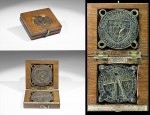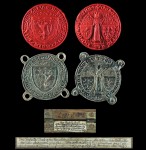 A unique double seal matrix commissioned by Robert the Bruce that is one of very few surviving objects linked directly to King Robert I has been sold to an overseas buyer and is in danger of leaving the UK. The seal sold at auction on December 4th, 2015, for £151,250 ($217,450), well above the pre-sale estimate of £80,000-120,000 ($115,140-172,710). The buyer is American and applied to the Culture Ministry for an export license. The Art Council’s Reviewing Committee on the Export of Works of Art and Objects of Cultural Interest (RCEWA) recommended that Culture Minister Ed Vaizey block export to give UK museums or collectors the opportunity to raise the purchase price and keep the artifact in the country.
A unique double seal matrix commissioned by Robert the Bruce that is one of very few surviving objects linked directly to King Robert I has been sold to an overseas buyer and is in danger of leaving the UK. The seal sold at auction on December 4th, 2015, for £151,250 ($217,450), well above the pre-sale estimate of £80,000-120,000 ($115,140-172,710). The buyer is American and applied to the Culture Ministry for an export license. The Art Council’s Reviewing Committee on the Export of Works of Art and Objects of Cultural Interest (RCEWA) recommended that Culture Minister Ed Vaizey block export to give UK museums or collectors the opportunity to raise the purchase price and keep the artifact in the country.
In 1315, Robert the Bruce granted the Abbey, with which he had a longstanding relationship and where he would be buried after his death, a royal charter.
“Robert, by the grace of God King of Scots, to all upright men in his whole land, greeting: Know ye that, for the safety of our own soul and that of our predecessors and successors, Kings of Scotland, we have given, granted, and by this our present Charter, have confirmed to God, the Blessed Mary the Virgin, the Church of the Holy Trinity, and St. Margaret, Queen of Dunfermlyn, and to the monks serving and to serve God for ever in the same, the right of patronage of the vicar Church of Inverkeithing, with the pertinents, as freely and quietly, fully, peacefully, and honourably as the predecessors formerly of Roger de Moubray, knight, who had forfeited it to us, have held and possessed the said right of patronage most freely, quietly, and honourably in all things, by rendering to us nothing therefore by only the suffrages of their prayers: Besides, we give and grant, and, by this our present charter, confirm to the foresaid monks, the whole of our new great Customs from all their lands within our kingdom, viz., the land of the burghs of Dunfermlyne, Kirkcaldy, Musselburgh, and Queensferry, and from all their other lands whatsoever; To also let the said monks have and use their own Koketa, according to the liberties of their regality, and our present concession in all their foresaid lands; and let this Koketa be acknowledged and admitted by all burgesses and our people, and foreign merchants throughout our whole kingdom, without obstruction from our chamberlains, or other servants of ours whatsoever for the time being, without petition from any other allocation of liberation, by finding for this our donation and concession of the said Customs for us and our successors, in honour of God and the Blessed Virgin Mary, and the aforesaid Blessed Margaret in the Choir in front of her shrine, one wax candle solemnly lighted, continually and forever. In testimony whereof we have caused our seal to be attached to our present Charter, these fathers being witnesses. William, and William, Bishops of St. Andrews and Dunkeld; Bernard, our Chancellor, the Abbot of Aberborthick; Duncan and Thomas Randolph, of Fife”
This charter granted the Abbey some lands and conferred the right to collect revenues from customs duties and taxes. The two-part bronze seal, known as a Cokete Seal, was commissioned by the Bruce for the Abbey to use on customs documents. We know the exact date it was made because there’s a record of it in the archives of Dunfermline Abbey: “The Cocquet Seal of the Regality Court of Dunfermline was engraven this year by sanction of King Robert the Bruce, by Chapter, dated at Scone, 10th July, 1322, along with letters patent to all who paid customs at Bruges, in Flanders, or elsewhere, notifying that wherever this Seal was in due form produced, it was to be recognised as the authority for collecting the customs granted to the Abbey by the King, &c.”
 The two parts were pressed together over a large blob of wax to form a seal. The wax seal would then be attached to an official document with a piece of parchment (for a brilliant example of attached seals acting as signatures, see the letter to Pope Clement VII from the peers of England asking for Henry VIII’s marriage to Catherine of Aragon to be annulled). The obverse seal matrix features an image of Saint Margaret, Queen consort of King Malcolm III of Scotland, founder and patron of Dunfermline Abbey, and is bordered with the Lombardic Latin legend “+ S’COKETE REGALITATIS.DE. DVNFERMELYNN,” (Cokete Seal of the regality of Dunfermline). The reverse features the royal arms of Scotland bordered with the legend “+ROBERTVS DEI GRACIA REX SCOTORVM” (Robert, by the Grace of God, King of the Scots).
The two parts were pressed together over a large blob of wax to form a seal. The wax seal would then be attached to an official document with a piece of parchment (for a brilliant example of attached seals acting as signatures, see the letter to Pope Clement VII from the peers of England asking for Henry VIII’s marriage to Catherine of Aragon to be annulled). The obverse seal matrix features an image of Saint Margaret, Queen consort of King Malcolm III of Scotland, founder and patron of Dunfermline Abbey, and is bordered with the Lombardic Latin legend “+ S’COKETE REGALITATIS.DE. DVNFERMELYNN,” (Cokete Seal of the regality of Dunfermline). The reverse features the royal arms of Scotland bordered with the legend “+ROBERTVS DEI GRACIA REX SCOTORVM” (Robert, by the Grace of God, King of the Scots).
The RCEWA made their recommendation on the grounds that it was of great value for the study of medieval goldsmith work and sigillography and the re-establishment of Scottish institutions under Robert the Bruce.
RCEWA Member Leslie Webster said:
“This remarkable and handsome seal-die is of national importance on several counts; it is closely linked to the charismatic figure of Robert the Bruce, and to the history and institutions of Scotland at a crucial time in its evolution as a nation; its association with the royal abbey of Dunfermline sheds light on how the king acted out his authority, delegating the powers of the crown; and its outstanding quality may suggest the influence of French craftsmen.”
The Scottish government has declared itself in support of all efforts that would keep the seal matrix in the UK, ideally in a Scottish museum, but there’s no official campaign that I could find. Here’s an Indiegogo campaign that’s been set up by a concerned individual who would use the funds to acquire the seal and donate it to the National Museum for Scotland. It’s less than 1% funded at this point, and I suspect the money is more likely to be raised by the institution itself tapping its private donors and launching a public campaign like the Victoria & Albert Museum did with Wolsey’s Angels. The National Museum already has an impression of the obverse in its collection. I imagine they’d be keen to have the original matrix pair.
Time’s awaistin’. The temporary bar expires on June 21st. If there’s a good faith effort to raise the money and it looks like they have a chance of reaching the goal, the deadline may be extended until September 21st.